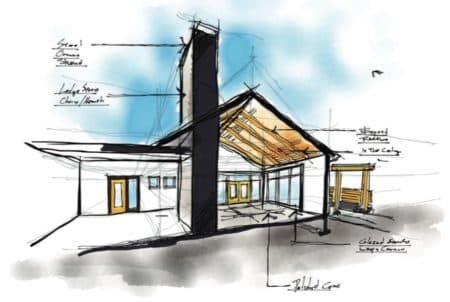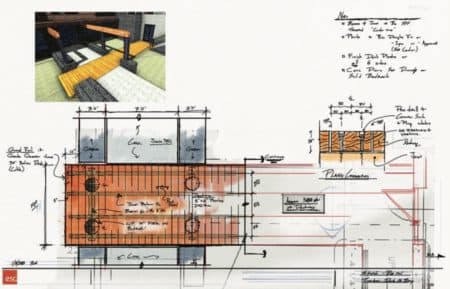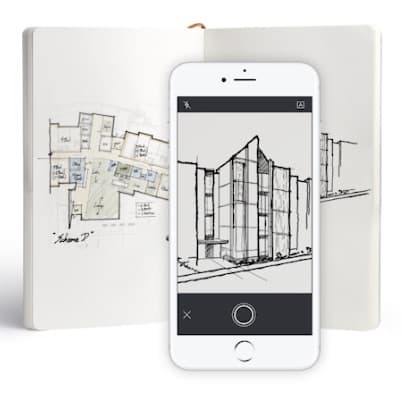If you look in a typical architect’s office today you will still find rolls of trace paper; free-form sketching has formed the backbone of the creative process for architects, and it isn’t going away—even in the face of BIM. Yes, it’s true that the average architect today is particularly preoccupied with staying on the cutting edge of digital technologies, but this ethos hasn’t supplanted hand drawn sketching.
For example, architects at Minneapolis-based architecture firm ESG Architecture and Design demonstrate how sketching still thrives as the fastest way to explore, and capture, and communicate ideas. The firm uses Autodesk SketchBook software for their hand drawing needs, and it fits neatly into their BIM-driven workflow.
Today’s model-based design tools bring power and intelligence to the design process. But they are data-based and can’t keep pace with what’s in the mind.
“Free-form drawing has always been part of the creative process, and it always will be,” says Mike Engel, a designer and design technologist at ESG. “Today’s model-based design tools bring power and intelligence to the design process. But they are data based and can’t keep pace with what’s in the mind. The only limit to the sketch process is the imagination. SketchBook brings the natural feel of drawing into our workflow.”
A Media Meant for Collaboration—Paper Is Not
While some architects are relying semi-foolishly upon the use of paper sketch pads, in today’s architectural practice the necessity to collaborate digitally is omnipresent. But how do you share sketches on paper? While possible, the effort to scan analog to digital is time-consuming.

01 – ESG Architects and Designers use Autodesk SketchBook as a key part of their BIM-based design workflow. By tapping the immediacy and power of the human mind when paired with free-hand sketching, ESG empowers their overall BIM process, using both Revit and SketchBook together in a back and forth workflow. (Image: ESG Architecture and Design and Autodesk / Architosh. All rights reserved.)
“Paper-based sketches present a few disadvantages as compared to a digital sketch process,” says Engel. “It’s just so much more practical to use a digital tool to draw. You want something that really feels like the simple act of drawing, but that also includes tools that make drawing part of a professional creative process.”
“ESG uses Autodesk SketchBook…it offers the simplicity we want with the professional features we need. For instance, the perspective tool delivers the same look you’d get using a large drafting board and finding your vanishing points. The straight edge tool,” he adds, “is like always having a ruler. You can sketch freely without worrying too much about rules of drafting. It’s a liberating path to a polished drawing.”
Bøden—Bringing Warmth to Concepts
ESG utilized Autodesk SketchBook for its work at the University of North Dakota for the Bøden apartments project. Dedicated study areas, furnished rooms, smart TVs and lots more provide students with comfortable living options. The project even has indoor bike parking, a student-pleasing feature.
From the earliest moments in schematic design, ESG’s designers used SketchBook software to capture and convey their ideas. Using the layer tool initial ideas were sketched out, showing alternatives like windows, roofs, and entries on various layers. It meant designers could quickly draw other options on the fly using the layers functionality. Paper sketch pads don’t have layers, and rolls of trace require tables to keep flat.

02 – In Autodesk SketchBook, which runs on Mac, Windows, iOS and Android devices, ESG can import photography, like in this example, for urban/site planning schematics. (Image: ESG Architecture and Design and Autodesk / Architosh. All rights reserved.)
During reviews with the client, standing or sitting, the team could quickly flip through the layers and show how the changes evolved and impacted the design and overall look. And photos were also brought into the reviews, those placed on their own layers to illuminate existing conditions worth noting.
“We get flexibility with SketchBook,” says Engel. “You can turn layers on and off to add speed to the iterative aspects of concept design. The client made informed choices based on sketches and models.”
Engle explained that ESG’s architects could shift between BIM models and drawings easily. “When you compare what was built,” he adds, “with the early sketches, the relationship is clear.”
Accelerating BIM By Hand
Some BIM advocates may suggest that the fastest most efficient design process is one where all your work takes place in one BIM program. This may be valid for a few firms on certain building and project types. But most architects need to rely on more complex tool-chains. But when you add analog into a digital workflow that’s an obvious pain-point waiting to be solved.

03 – An excellent example of ESG’s use of SketchBook utilizing color overlays, photo drop-ins, and high-quality architectural sketching. (Image: ESG Architecture & Design and Autodesk / Architosh. All rights reserved.)
For ESG the design team used sketch drawings as “underlays” in their Autodesk Revit BIM software, to guide model design development. Working it the other way, the team could bring renderings of the 3D geometry BIM model back into SketchBook to further sketch over. This really helped the client explore finer detail options quickly in the later stages of the design process.
“A sketch is not necessarily as rich as a 3D model, but can be a quick way to identify the options the clients would like refined,” says Engel. “In the time it might take to model two options, you can sketch five or six in SketchBook.”
“You help the client find the most effective and efficient solution, faster,” he said. “It’s easy to then use the drawing as an underlay in Revit and start refining and modeling the idea.”
The Results: Mobility and Handmade
The architects at ESG can take the SketchBook software anywhere with them because it runs on mobile devices. They simply log in from their device and start drawing as they would with a sketch pad. But SketchBook is far more sophisticated than a sketch pad; tablets are intelligent devices integrated into all-digital collaborative workflows. Mobile devices operate through the cloud offering new ways for architects to serve clients and their stakeholders.

04 – An image by Engel showing how SketchBook is the smart, digital equal of the common sketch pad. Except, sketch pads don’t have layers and digital collaboration features. (Image: Autodesk / Architosh. All rights reserved.)
While technology is powering improvements in the architectural delivery process, there remains a soft spot for hand drawings for all the reasons already mentioned. So ESG’s architects are glad that SketchBook helps them include a sketching process into today’s BIM-based workflows.
“SketchBook delivers the freedom of free-form drawing,” says Engel. “We have a few clients who really love the warmth that comes from a hand-drawn sketch, even if it’s digital.”




Reader Comments
Autodesk used to have something called Sketchbook Designer which mixed vector and image based graphics – perfect for architects. I loved it! Now, only Sketchbook and image based drawing is possible and the tool lost a huge appeal to me.
Autodesk used to have something called Sketchbook Designer which mixed vector and image based graphics – perfect for architects. I loved it! Now, only Sketchbook and image based drawing is possible and the tool lost a huge appeal to me.
What device are they sketching on, Tablet, Desktop tablet, Ipad ? I find that the sketching experience with any app is greatly influenced by the input device. Up until now, the more expensive the better.
What device are they sketching on, Tablet, Desktop tablet, Ipad ? I find that the sketching experience with any app is greatly influenced by the input device. Up until now, the more expensive the better.
Dead readers comments, Blah! What’s the point?
Dead readers comments, Blah! What’s the point?
Sorry about that Patrick! It’s been one of those crazy past 48 hours. Normally I am much better than this. I would say you add many good points. I would counter that having platform flexibility is a great benefit so if you know Wacom tablets versus Apple Pencil on an iPad then you can take advantage on the platform you know.
JP, the SketchBook Designer product I believe came with the Alias acquisition. I may be mistaking but I believe that is the case. It is really interesting to here you say you used that for architecture.
Sorry about that Patrick! It’s been one of those crazy past 48 hours. Normally I am much better than this. I would say you add many good points. I would counter that having platform flexibility is a great benefit so if you know Wacom tablets versus Apple Pencil on an iPad then you can take advantage on the platform you know.
JP, the SketchBook Designer product I believe came with the Alias acquisition. I may be mistaking but I believe that is the case. It is really interesting to here you say you used that for architecture.
Comments are closed.